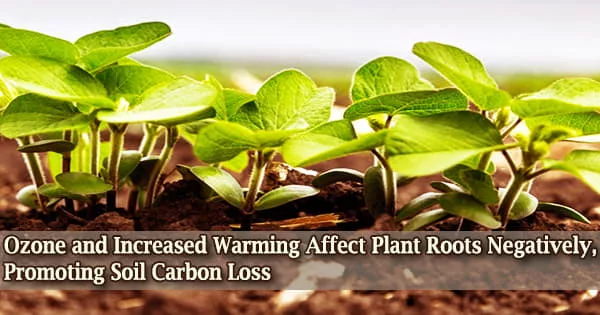Two important elements that contribute to climate change are the roots of soybean plants, their interactions with symbiotic soil microorganisms, and how the plants sequester carbon all appear to be negatively impacted by rising climatic warming and elevated ozone levels.
The findings, which were reported in the Science Advances edition of July 9 (2021), indicate that there have been few changes to the plant shoots above ground but some troubling developments underground, including a worsening inability to store carbon, which is instead released into the atmosphere as a greenhouse gas.
Arbuscular mycorrhizal fungi (AMF) are important underground organisms that support chemical interactions that hold carbon in the ground by preventing the decomposition of soil organic matter, thereby halting the escape of carbon from the decomposing material. Researchers from North Carolina State University looked at the interaction of warming and increased ozone levels with AMF.
“The ability to sequester carbon is very important to soil productivity in addition to the detrimental effects of increasing greenhouse gases when this carbon escapes,” said Shuijin Hu, professor of plant pathology at NC State and corresponding author of the paper.
AMF have a beneficial interaction with plants and are found in the roots of around 80% of land plants. While providing nitrogen and other important soil elements that plants require in order to grow and develop, AMF removes carbon from plants.
In the experiment, scientists set up soybean plots with elevated air temperatures of roughly 3 degrees Celsius, elevated ozone levels, elevated warming levels, and elevated ozone levels, and unaltered control plots. The investigations that followed revealed that as a result of warming and elevated ozone levels, soybean roots became thinner in order to conserve resources and obtain the nutrients they require.
Ozone and warming make the plants weak. Plants try to maximize nutrient uptake, so their roots become thinner and longer as they need to exploit the sufficient volume of soil for resources. This weakness results in a reduction of AMF and faster root and fungal hyphal turnovers, which stimulates decomposition and makes carbon sequestration more difficult. These cascading events may have profound effects underground, although the plant shoots appear normal in some cases.
Professor Shuijin Hu
According to Hu, soybean varieties are frequently ozone sensitive. Over the past ten years, ozone levels have fluctuated somewhat or even decreased in some areas of the United States, but they have drastically increased in places that are undergoing fast industrialization, such as China and India.
“Ozone and warming have been shown to be very stressful to a lot of crops not just soybeans and a lot of grasses and tree species,” Hu said.
“Ozone and warming make the plants weak. Plants try to maximize nutrient uptake, so their roots become thinner and longer as they need to exploit the sufficient volume of soil for resources. This weakness results in a reduction of AMF and faster root and fungal hyphal turnovers, which stimulates decomposition and makes carbon sequestration more difficult. These cascading events may have profound effects underground, although the plant shoots appear normal in some cases.”
Hu expressed his surprise that the pressures of warming and ozone had little to no impact on plant shoots, as seen by the almost same biomass of plant leaves in the experimental and control plots.
Even more unexpectedly, Hu claimed that ozone and global warming altered the sort of AMF that colonize soybean plants.
According to the study, levels of the AMF species Paraglomus grew whereas levels of the species Glomus declined with increased warmth and ozone.
“Glomus protects organic carbon from microbial decomposition while Paraglomus is more efficient at absorbing nutrients,” Hu said. “We didn’t expect these communities to shift in this way.”
Hu intends to carry out additional research on the mechanisms governing soil carbon sequestration as well as other greenhouse gas emissions from soil, such as nitrous oxide, or N2O.
















